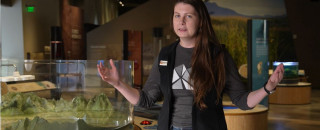Museum on the Move: Crosscutting Concepts
Museum on the Move is here to support you and highlight local examples of our own crosscutting concepts. During your Museum on the Move visit we highlight the concepts that align most closely with the standards, however these are crosscutting concepts and they touch many other scientific studies!
Below you’ll find some phenomenal videos that demonstrate the way we can apply these concepts to different fields like Biology, Paleontology, and Archaeology!
Want more background on crosscutting concepts? Check out these resources from the NGSS.
Structures and Functions
Structures, i.e. shapes, on natural and human-made things all have a purpose, a Function. The round shape of a soccer ball allows it to roll, the sharp point of a thorn allows it to prick and protect itself, and the thick leg bones of a Barosaurus allow it to hold tremendous weight. Every shape has a purpose, every structure has a function, by observing a structure's shapes and details we can make inferences about the function of the structure. For example, observing gills on an animal would lead a student to the conclusion that this animal breathes underwater. We can see structure and function all around us in both human-made and natural objects and specimens. Some of human's best ideas came from structures in nature! There isn't much difference between the shape of an umbrella and a large broad palm leave, or armor and the overlapping scales of a snake!
- Encourage your students to observe things around the classroom and identify structure and function in human-made objects. Follow this up with a trip outdoors! Can your students identify similar structures between natural and human-made? What is the function of these structures?
- Have a student pick an animal and write down three noticeable structures. How do these structures help that animal survive?
- Use our guided notes to keep track of your observations if that is helpful to your students
Structures and Functions
Systems
Systems are when individual things that interact together to form a unified whole. There are many natural and human made systems in our world. The water cycle is a natural system fueled by the Sun’s energy that creates weather, provides drinking water for living organisms, and can even change the landscape. Animals are also part of systems by what they eat; their relationship with one another in a habitat. An example would be Hawks that feed on Deer Mice, which feed on Grass and Seeds. Human systems like irrigation and agriculture provide us with our survival needs by changing natural resources.
- Have students draw a map of where water comes from and where it is going. From starting in the sky and then returning to the sea (or in our case the Great Salt Lake). Have them think about how they use water in their daily lives and it’s importance.
- Have students find connections between animals and plants in a given habitat. You can divide students into groups including Mountain, Desert, Wetland and have them pick a living organism in each habitat. With a little role play and sharing you can have students share their role in the habitat and the way their animal or plant relates to one another.
- Have students brainstorm creating a system using a few everyday household items to create a useful tool to make their lives easier and meet their survival needs . Have to use at least 3 objects together to serve a function like food prep, shelter, storage, comfort.
Systems
Stability and Change
All natural phenomenon have observable Stability and Change. The biggest force that affects Stability and Change is time. Sometimes this change can happen slowly or quickly. An insect can grow up to an adult in months but a mountain may take millions of years to rise. An object can be stable unless an outside force acts upon it. For instance, a rock may be stable on a hillside but freezing and thawing may dislodge the rock and it changes by tumbling down a hillside. Finally, dynamic stability is when a system goes through significant changes but returns to a stable state each time. The Earth revolves around the Sun every year, a tree changes its appearance throughout the months, and forest will grow back after a fire.
Have students observe how Stability and Change can vary based on length of time such as:
- A hot glass of water cools down and stabilize in minutes
- Shadows length and position change throughout the day
- Sunrise and Sunset times throughout the month (and remain consistent to every month before it)
- A baby bird, through a trail cam, grows up over a few months
- An animal like ancient horses change while retaining stable structures over millions of years
Stability and Change
Patterns
Patterns are repeated shapes and structures that you can find in natural and human made things. In nature, we see patterns like flower petals and animal hair or scales, but patterns can also be observed in natural behaviors like birds migrating every year or bears hibernating when it gets cold. Human made technologies also have repeated shapes and structures that help you understand their function. As well as rock and earth layers show patterns that tell you how environments looked like millions of years ago!
- Encourage your students to observe things around the classroom or at home and identify patterns in human-made objects. Follow this up by a trip outdoors! Can your students identify patterns in nature and natural behaviors? Take some time to explore and when you find your favorite example of a pattern ask your students to try to draw it and then discuss what that pattern means and what is its function.
- Have students go through Utah habitats; Forest, Wetlands, and Desert. Observe roles that animals and plants achieve in their environment.
Patterns
